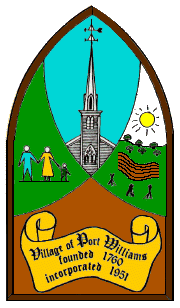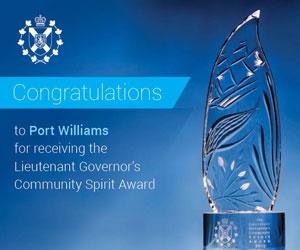Our Beginnings
In 1856, Terry's Creek (named after Captain John Terry, a Planter pioneer) was given the name of Port Williams after Sir William Fenwick Williams, Bart. A professional soldier, he became commander-in-chief of the British forces in Canada in 1859-65 and was Lieutenant-Governor of Nova Scotia in 1865-76.
The Cornwallis River was named after Edward Cornwallis, the first governor of Nova Scotia after the capital was transferred from Annapolis Royal to Halifax in 1749, eleven years before the arrival of the Planters.
- from Place Names in Kings Co. Watson Kirkonnell 1971.
The Mi'kmaq once called Starr's Point, which lies between the Canard and Cornwallis rivers Nesoogwitk - "extending between two rivers".
From Starr's Point to the turn into Kentville, a distance of about 7 miles, is Church Street. It was so named because, over the years, there have been several churches on the street. Only St. John's Anglican church now remains.
- Kings Co. Vignettes by Elizabeth Rand June 1989
The Port Remembers: The History of Port Williams and its Century Homes is a compilation of village history undertaken in 1973 as a 60th Anniversary Project of the Port Williams Women's Institute and was published in 1976.
The Planter's Monument, erected in honour of the New England Planters who landed on this bank (then known as Boudreau's Bank) on June 4, 1760, is situated off Starr's Point Road at Willowbank.
Turn north from Church Street toward Canard Street to view the Wellington Dyke. This dyke, when it was finally completed in 1825, was the culmination of at least a century of toil and risks by Acadians, New England Planters, and subsequent farmers in the Canard River Valley. These groups, while having only the most primitive tools and equipment and methods, eventually succeeded in winning from the sea, over two thousand acres of prime farmland. Unlike most of the other early major dyking systems in Kings County - and, indeed, Nova Scotia - those efforts on the Canard River were based upon aboiteaux or cross dykes. This type of dyking involved, in effect, the damming of the entire river bed and valley from the tides, while letting out the fresh river water and drainage. Constant repair, maintenance, and improvement have been required ever since - the most extensive work having been carried out in the mid-1940's and the mid-1970's.
- The Wellington Dyke: A History of the Canard River Dyke System, Brent Fox, 1985Port Williams is one of the best places on earth to see the vertical rise and fall of the World's Highest Tides. The water level at high tide can be as much as 16 metres (52 ft.) higher than low tide. Tides happen every 12 hours and 25 minutes (or nearly an hour later each day).
Port Williams participates each year in the Annapolis Valley Apple Blossom Festival. The following Princesses represented Port Williams and became Queen Annapolisa.
- 1939 Geraldine Clark
- 1961 Carol Harris
- 1968 Beverley McDow
- 1991 Kerry Ann Atwater
- 2012 Samantha Whynot
Port Williams Crest
 Port Williams has its own pin available at the Village Office. The pin is a facsimile of the Port Williams Crest. The gothic style of the emblem is representative of the large stained glass window of St. John's Anglican Church. As well, the United Baptist Church (centre) was chosen as the most notable landmark in the Village. These focus on the Christian faith of our community.
Port Williams has its own pin available at the Village Office. The pin is a facsimile of the Port Williams Crest. The gothic style of the emblem is representative of the large stained glass window of St. John's Anglican Church. As well, the United Baptist Church (centre) was chosen as the most notable landmark in the Village. These focus on the Christian faith of our community.The symbolic family denotes the importance of family and community life. A spirit which is evident in the day to day activities of Port Williams.
The farmland scene depicts our rich agricultural heritage.
The brown background of the scroll represents the red clay banks of the Cornwallis River.
Port Williams was founded in 1760 and incorporated as a Village in 1951.
Prescott House
 Prescott House is one of the finest examples of Georgian architecture existing in Nova Scotia. Foundations were laid in 1799 and it took 3 years to complete. It was built by Charles Prescott (1772-1859) famous for his work in horticulture, especially the introduction of new varieties of apples including the popular Gravenstein.
Prescott House is one of the finest examples of Georgian architecture existing in Nova Scotia. Foundations were laid in 1799 and it took 3 years to complete. It was built by Charles Prescott (1772-1859) famous for his work in horticulture, especially the introduction of new varieties of apples including the popular Gravenstein.Port Williams Wharf
 In the day of sailing vessels, the wharf was extensively used in shipping lumber, potatoes and apples to world markets. A new 230 ft. long wharf was built in 1930 along with a steamer berthing bed. In 1938, shipments of apples to Great Britain and European ports soared to half a million barrels. Imports included coal from England & Wales, fertilizer materials, grain and flour. From 1950-71 pulpwood was shipped from the port. Since 1928, ships of the following nationalities have docked at Port Williams: Danish, Finnish, Swedish, Norwegian, British, Dutch, Spanish, Mexican, German, Italian, Greek, Russian, Icelandic, Canadian and American. In 1972, the government appropriated over $100,000 to repair and renovate the wharf. In 1975, the German ship, "Antares" the widest ship ever to dock here, and with a carrying capacity of 6,000 tons, brought a cargo of soybean meal from Chicago. Vintage LowtideVintage Lowtide: This photograph was taken circa 1886 of the docksideat Port Williams with two boats in the mud. It belongs to the collection at Randall House, Wolfville.
In the day of sailing vessels, the wharf was extensively used in shipping lumber, potatoes and apples to world markets. A new 230 ft. long wharf was built in 1930 along with a steamer berthing bed. In 1938, shipments of apples to Great Britain and European ports soared to half a million barrels. Imports included coal from England & Wales, fertilizer materials, grain and flour. From 1950-71 pulpwood was shipped from the port. Since 1928, ships of the following nationalities have docked at Port Williams: Danish, Finnish, Swedish, Norwegian, British, Dutch, Spanish, Mexican, German, Italian, Greek, Russian, Icelandic, Canadian and American. In 1972, the government appropriated over $100,000 to repair and renovate the wharf. In 1975, the German ship, "Antares" the widest ship ever to dock here, and with a carrying capacity of 6,000 tons, brought a cargo of soybean meal from Chicago. Vintage LowtideVintage Lowtide: This photograph was taken circa 1886 of the docksideat Port Williams with two boats in the mud. It belongs to the collection at Randall House, Wolfville.Post Office
 In the early days there were five post offices in Port Williams and its immediate surroundings. The central office in Port Williams began in 1858, and it distributed mail to four other offices.
In the early days there were five post offices in Port Williams and its immediate surroundings. The central office in Port Williams began in 1858, and it distributed mail to four other offices. June 3rd, 2000 was considered an historic day by Port Williams post office staff and local residents when a new post office cancellation stamp was first used. The concept originated with Kenneth Bezanson who has the postmark designed by noted Cape Breton songwriter, Allister MacGillivray. The stamp harks back to the era of sailing ships when village folk say Port Williams was referred to as "the Biggest Little Port in the world". Port Williams now has the first postmark in the Valley.
